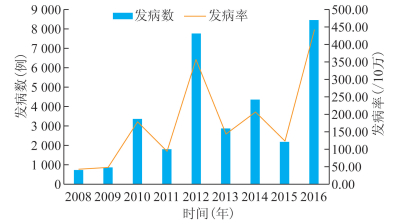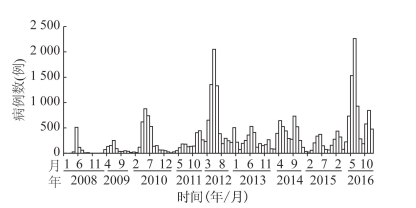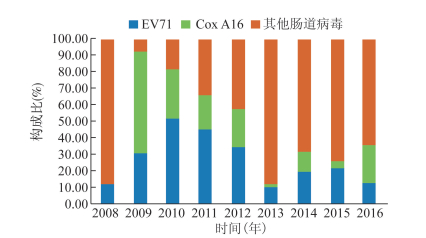扩展功能
文章信息
- 傅涛, 叶晓军, 骆淑英, 朱列波, 陶静波, 吴非
- Fu Tao, Ye Xiaojun, Luo Shuying, Zhu Liebo, Tao Jingbo, Wu Fei
- 2008-2016年浙江省义乌市手足口病流行特征研究
- Epidemiological characteristics of hand, foot and mouth disease in Yiwu, 2008-2016
- 疾病监测, 2018, 33(1): 50-53
- Disease Surveillance, 2018, 33(1): 50-53
- 10.3784/j.issn.1003-9961.2018.01.012
-
文章历史
- 收稿日期:2017-06-30
手足口病是由多种人肠道病毒引起的急性传染病,多见于学龄前儿童,主要症状有发热及手、足、口腔部位的皮疹、溃疡,少数患者可出现无菌性脑膜炎、脑干脑炎、急性弛缓性麻痹、神经源性肺水肿和心肌炎等,个别重症患儿病情进展快,可导致死亡。2008年将手足口病纳入我国丙类法定报告传染病管理。
义乌市地处浙江省中部,属亚热带季风气候,商贸业发达,流动人口众多,本地户籍人口不到100万人,但每年外来人口均超过本地户籍人口。手足口病是义乌市的重大公共卫生问题,近年来每年均有数千例病例报告,而且2016年疫情形势更加严峻,为掌握义乌市手足口病流行特征,本研究对义乌市2008—2016年手足口病的流行特征进行分析。
1 资料与方法 1.1 资料来源手足口病病例的年龄、性别、职业、住址、发病时间、诊断时间、重症、死亡及病原学信息等均来自“中国疾病预防控制信息系统”。
1.2 数据分析采用Excel 2013软件建立手足口病数据库,并对其病例的时间、空间、人间分布状况和病原学检测结果进行分析。
2 结果 2.1 疫情概况2008—2016年义乌市共报告手足口病病例32 554例,其中男性20 613例,女性11 941例,不同年份的男女性别比不完全相同(χ2=41.939,P=0.001);年度病例呈波动状态,2016年和2012年病例数最多,分别为8 458例和7 724例,占所有累计病例的48.79%(图 1);死亡12例,病死率为0.04%。发病率的波动与发病数类似,也是2012年和2016年较高,见图 1。死亡病例中男性10例,女性2例;10例年龄≤ 1岁,2例年龄为3岁;10例为肠道病毒71型(EV71)感染,2例为其他肠道病毒感染。

|
| 图 1 2008—2016年义乌市手足口病报告情况 Figure 1 Reported cases of HFMD in Yiwu, 2008-2016 |
| |
全年均有病例报告,其中4—7月报告的病例数最多,占60.64%(19 742/32 554),不同年份的月分布不完全相同(χ2=9 159.738,P=0.001)。主要呈现为5月前后的主高峰和12月前后的次高峰,2008—2010年、2012—2013年和2015—2016年报告的病例数以5月和6月最多,2011年以11月和12月病例数最多,见图 2。

|
| 图 2 2008—2016年义乌市报告手足口病病例月分布 Figure 2 Monthly distribution of HFMD cases reported in Yiwu, 2008-2016 |
| |
稠城街道、江东街道、北苑街道和稠江街道累计报告的病例数最多,分别为7 045、5 793、4 266和4 163例,占义乌市所有报告病例数的65.33%(21 267/32 554),其他9个街道(镇)也均有病例报告,见表 1。江东街道、稠城街道、后宅街道、稠江街道和北苑街道的累计发病率较高,而大陈镇、赤岸镇和佛堂镇的累计发病率较低(表 1)。
| 地区 | 2008年 | 2009年 | 2010年 | 2011年 | 2012年 | 2013年 | 2014年 | 2015年 | 2016年 | 合计 | 累计发病率(/10万) |
| 稠城街道 | 171 | 191 | 693 | 395 | 1 647 | 560 | 837 | 468 | 2 083 | 7 045 | 2 608.19 |
| 江东街道 | 118 | 132 | 523 | 382 | 1 347 | 619 | 925 | 458 | 1 289 | 5 793 | 2 634.62 |
| 北苑街道 | 112 | 88 | 440 | 282 | 1 057 | 414 | 613 | 296 | 964 | 4 266 | 2 089.15 |
| 稠江街道 | 68 | 106 | 306 | 246 | 998 | 341 | 562 | 244 | 1 292 | 4 163 | 2 475.02 |
| 佛堂镇 | 48 | 43 | 397 | 74 | 269 | 107 | 125 | 64 | 240 | 1 367 | 954.38 |
| 后宅街道 | 43 | 63 | 252 | 96 | 429 | 204 | 312 | 123 | 485 | 2 007 | 2513.15 |
| 义亭镇 | 38 | 51 | 140 | 50 | 373 | 110 | 147 | 53 | 362 | 1 324 | 1 741.65 |
| 廿三里街道 | 35 | 34 | 113 | 55 | 323 | 125 | 178 | 98 | 382 | 1 343 | 1 005.06 |
| 城西街道 | 30 | 67 | 155 | 54 | 368 | 127 | 191 | 57 | 391 | 1 440 | 1 640.37 |
| 上溪镇 | 25 | 16 | 108 | 59 | 232 | 119 | 117 | 104 | 256 | 1 036 | 1 286.76 |
| 大陈镇 | 23 | 8 | 45 | 41 | 131 | 69 | 107 | 45 | 111 | 580 | 745.03 |
| 苏溪镇 | 21 | 65 | 153 | 78 | 484 | 108 | 229 | 164 | 499 | 1 801 | 1 601.29 |
| 赤岸镇 | 14 | 21 | 64 | 30 | 66 | 33 | 26 | 22 | 104 | 380 | 784.12 |
| 不详 | 1 | 1 | 2 | 3 | 0 | 2 | 0 | 0 | 0 | 9 |
病例年龄以≤5岁的儿童为主,占95.76%,而且每年的病例均以≤5岁的儿童为主,见表 2。病例职业以散居儿童和幼托儿童为主,分别为20 877例(64.13%)和10 860例(33.36%),个别病例职业为农民、家务及待业、教师等。
| 年份 | 病例总数 | ≤5岁人数 | 构成比(%) | ≤5岁发病率(/10万) | 平均年龄(岁) |
| 2008 | 747 | 709 | 94.91 | 644.21 | 2.21 |
| 2009 | 886 | 857 | 96.73 | 646.11 | 1.97 |
| 2010 | 3 391 | 3 291 | 97.05 | 2 259.26 | 2.00 |
| 2011 | 1 845 | 1 806 | 97.89 | 1 194.36 | 1.95 |
| 2012 | 7 724 | 7 444 | 96.37 | 4 378.13 | 2.17 |
| 2013 | 2 938 | 2 822 | 96.05 | 1 787.14 | 1.88 |
| 2014 | 4 369 | 4 166 | 95.35 | 2 505.70 | 2.29 |
| 2015 | 2 196 | 2 110 | 96.08 | 1 254.80 | 2.27 |
| 2016 | 8 458 | 7 969 | 94.22 | 4 540.56 | 2.42 |
| 合计 | 32 554 | 31 174 | 95.76 | 2 263.20 | 2.13 |
2008— 2016年发病至确诊时间间隔分别为2.50、2.65、1.89、2.05、1.63、1.86、2.03、2.25和1.42 d,2016年的时间间隔略有下降。
2.6 病原学检测义乌市2008—2016年共检测手足口病样本796份,其中631份阳性,阳性率为79.27%,检测到的病原体主要为EV71、Cox A16以及其他肠道病毒,见图 3。

|
| 图 3 2008—2016年义乌市报告手足口病检测结果 Figure 3 Result of pathogen detection of HFMD reported in Yiwu, 2008-2016 注:EV71:肠道病毒71型;Cox A16:柯萨奇病毒A组16型 |
| |
自2008年5月手足口病被纳入我国乙类法定报告传染病管理以来,义乌市自2010年以来每年均有上千例病例报告,尤其是2012年和2016年,报告病例数更多,可能是气温、湿度等气象因素和人口流动等社会因素影响了手足口病的发病率,日本、中国香港和大陆地区的研究结果表明,气象因素可以影响手足口病的发病率[1-4];另一方面,不同年份病例报告标准存在差异也可影响报告的病例数。本研究发现2016年报告病例数大幅上升,提示需要进一步加强对手足口病防控的重视,采取更有效的措施对其进行预防控制。
义乌市每月均有手足口病病例报告,累计病例以4—7月最多,与江苏省宜兴市、浙江全省、云南省保山市、上海市杨浦区等的研究结果类似[5-8],与西藏自治区、大连市等地区的研究结果有差异[9-10]。不同年份的发病高峰不同,尤其是2011年11月和12月报告的病例数最多,除气象因素影响外,其他原因尚需进一步调查,提示在非流行季节也要提高监测预警。
义乌市各个街道(镇)均有病例报告,但稠城街道、江东街道、后宅街道、北苑街道和稠江街道的累计发病率较高,可能与该5个街道流动人口较多、人口较为密集等有关。病例主要集中在≤5岁的散居儿童和幼托儿童,提示该人群为手足口病防控的重点人群。
病原学检测结果表明,2008年手足口病主要的病原体为其他肠道病毒,2010年手足口病主要的病原体为EV71,2013年之后其他肠道病毒又占绝对优势,提示不同年份的优势病原体会转化变迁。需加强手足口病的病原学检测,清楚不同年份的优势病原体,为手足口病的精准防控提供科学依据。
作者贡献:
傅涛 ORCID:0000-0001-6663-424X
傅涛:论文设计
骆淑英:论文撰写、修改
叶晓军、朱列波、陶静波、吴非:数据整理及分析
| [1] |
Onozuka D, Hashizume M. The influence of temperature and humidity on the incidence of hand, foot and mouth disease in Japan[J]. Sci Total Environ, 2011, 410-411: 119-125. DOI:10.1016/j.scitotenv.2011.09.055 |
| [2] |
Ma E, Lam T, Wong C, et al. Is hand, foot and mouth disease associated with meteorological parameters?[J]. Epidemiol Infect, 2010, 138(12): 1779-1788. DOI:10.1017/S0950268810002256 |
| [3] |
曹立华, 任敏, 赵培利, 等. 手足口病与气候关系的探讨和研究[J]. 中华实验和临床病毒学杂志, 2011, 25(3): 227-229. Cao LH, Ren M, Zhao PL, et al. A exploration and study of the relationships of hand, foot and mouth disease(HFMD)and the climate[J]. Chin J Exp and Clin Virol, 2011, 25(3): 227-229. DOI:10.3760/cma.j.issn.1003-9279.2011.03.022 |
| [4] |
于吉广, 刘友德, 乔令艳, 等. 烟台地区手足口病931例流行病学及临床特征分析[J]. 中华实验和临床病毒学杂志, 2011, 25(10): 374-376. Yu JG, Liu YD, Qiao LY, et al. Epidemiological study and clinical analysis of 931 children with hand, foot and mouth disease in Yantai[J]. Chin J Exp Clin Virol, 2011, 25(10): 374-376. DOI:10.3760/cma.j.issn.1003-9279.2011.05.018 |
| [5] |
丁超, 谭文文, 周建刚, 等. 2008—2011年江苏省宜兴市手足口病流行特征分析[J]. 疾病监测, 2012, 27(7): 527-529. Ding C, Tan WW, Zhou JG, et al. Epidemiology of hand, foot and mouth disease in Yixing, Jiangsu, 2008-2011[J]. Dis Surveill, 2012, 27(7): 527-529. DOI:10.3784/j.issn.1003-9961.2012.7.008.j.issn.1003-9961.2012.7.008 |
| [6] |
吴晨, 吴昊澄, 丁哲渊, 等. 2008—2015年浙江省手足口病流行特征分析[J]. 疾病监测, 2016, 31(10): 831-837. Wu C, Wu HC, Ding ZY, et al. Epidemiology of hand, foot and mouth disease in Zhejiang, 2008-2015[J]. Dis Surveill, 2016, 31(10): 831-837. DOI:10.3784/j.issn.1003-9961.2016.10.008 |
| [7] |
黄东升, 杨明强, 何恺, 等. 2008—2014年云南省保山市手足口病的流行与病原特征分析[J]. 疾病监测, 2016, 31(3): 215-219. Huang DS, Yang MQ, He K, et al. Epidemiological and etiological characteristics of hand, foot and mouth disease in Baoshan, Yunnan, 2008-2014[J]. Dis Surveill, 2016, 31(3): 215-219. DOI:10.3784/j.issn.1003-9961.2016.03.009 |
| [8] |
乔鹏, 胡晶晶, 刘敏, 等. 上海市杨浦区2009—2013年手足口病流行特征分析[J]. 第二军医大学学报, 2015, 36(1): 44-48. Qiao P, Hu JJ, Liu M, et al. Hand, foot and mouth disease in Yangpu district of Shanghai: an analysis of epidemiologic characteristics in 2009 -2013[J]. Acad J Second Mil Med Univ, 2015, 36(1): 44-48. DOI:10.3724/SP.J.1008.2015.00044 |
| [9] |
达珍, 次仁顿珠, 彭措次仁, 等. 2009—2013年西藏自治区手足口病流行特征分析[J]. 疾病监测, 2014, 29(11): 862-866. Dazhen, Cirendunzhu, Pengcuociren, et al. Epidemiology of hand foot and mouth disease in Tibet, 2009 -2013[J]. Dis Surveill, 2014, 29(11): 862-866. DOI:10.3784/j.issn.1003-9961.2014.11.006 |
| [10] |
范雪松, 于蕾, 潘立阳, 等. 大连市2008—2012年手足口病流行特征及主要病原学分析[J]. 中国卫生统计, 2014, 31(2): 206-208. Fan XS, Yu L, Pan LY, et al. Analysis of the epidemiological and etiological characteristics on hand, foot and mouth disease in Dalian city from 2008 to 2012[J]. Chin J Health Stat, 2014, 31(2): 206-208. |
 2018, Vol. 33
2018, Vol. 33


